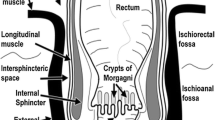Abstract
Background:Harmonic imaging (HI) is a relatively new US method. Its usefulness in children has yet to be determined. Objective: To evaluate the value of HI in urinary tract imaging of infants and children. Materials and methods: The bladder and kidneys of 29 unselected patients, aged 2 months to 12.8 years (mean, 6.8 years), were examined from ventral and dorsal approaches using conventional (= fundamental) imaging (FI) (6.5 and 3.4 MHz) and HI (3.3 MHz). In addition to global image quality, visualization of bladder wall, retrovesical space, renal contrast to liver/spleen, the pelvicalyceal systems, and the difference between cortex and medulla were assessed. Parameters were rated by two independent examiners and statistical analysis was performed. Results: There were significant differences between the three imaging settings for all parameters studied (P<0.003). With the dorsal approach, HI was superior to FI for all parameters analysed (P<0.05). Using the ventral approach, a significant improvement of imaging with HI was found for the bladder and the renal pelvis (P<0.02). Conclusions: HI is a useful additional tool for imaging the urinary tract in children of all ages. The method particularly improves visualization of the bladder and the kidney from a dorsal approach.




Similar content being viewed by others
References
Freiherr G (1998) Harmonic imaging: what it is and how it works. Diagn Imaging Europe HU6-HU7
Tranquart F, Grenier N, Eder V, et al (1999) Clinical use of ultrasound tissue harmonic imaging. Ultrasound Med Biol 25:889–894
Blaivas M, DeBehnke D, Sierzenski PR, et al (2002) Tissue harmonic imaging improves organ visualization in trauma ultrasound when compared with standard ultrasound mode. Acad Emerg Med 9:48–53
Shapiro RS, Wagreish J, Parsons RB, et al (1998) Tissue harmonic imaging sonography: evaluation of image quality compared with conventional sonography. AJR 171:1203–1206
McMahon CJ, Fraley JK, Kovalchin JP (2001) Use of tissue harmonic imaging in pediatric echocardiography. Cardiol Young 11:562–564
Ryu JA, Kim B, Kim S, et al (2003) Ultrasound evaluation of normal and abnormal fetuses: comparison of conventional, tissue harmonic, and pulse-inversion harmonic imaging techniques. Korean J Radiol 4:184–190
Hosono T, Chiba Y, Kanai H, et al (2002) Initial experience of tissue harmonic imaging in the diagnosis of fetal cardiac tumors. Ultrasound Obstet Gynecol 19:400–402
Paladini D, Vassallo M, Tartaglione A, et al (2004) The role of tissue harmonic imaging in fetal echocardiography. Ultrasound Obstet Gynecol 23:159–164
Dybiec E, Brodzisz A, Pietka M, et al (2002) The application of ultrasound contrast, 3D imaging and tissue harmonic imaging in the differential diagnosis of lymph node enlargement in children. Ann Univ Mariae Curie Sklodowska 57:131–142
Darge K, Ziegler B, Rohrschneider W, et al (2001) Contrast-enhanced harmonic imaging for the diagnosis of vesicoureteral reflux in pediatric patients. AJR 177:1411–1415
Choudry S, Gorman B, Charboneau JW, et al (2000) Comparison of tissue harmonic imaging with conventional US in abdominal disease. Radiographics 20:1127–1135
Flunker S, Aube C, Anglade E et al (2001) Value of tissue harmonic imaging in biliary lithiasis (in French). Gastroenterol Clin Biol 25:589–594
Littmann M, Schwaiger U, Sczepanski B, et al (2001) Improved ultrasound imaging of the pancreas with the transsplenic view and tissue harmonic imaging (in German). Ultraschall Med 22:163–166
Schiemann U, Dieterle C, Gödieresistzberger M, et al (2003) Improved examination of pancreas grafts in type I (insulin-dependent) diabetic patients using tissue harmonic imaging. Transplant Proc 35:3081–3084
Sparchez Z (2003) Tissue harmonic imaging: is it useful in hepatobiliary and pancreatic ultrasound? Rom J Gastroenterol 12:239–246
Jung EM, Clevert DA, Lutz R, et al (2002) Preoperative wire localisation of breast lesions by tissue harmonic imaging (THI) sonography (in German). Rofo Fortschr Geb Rontgenstr Neuen Bildgeb Verfahr 174:1121–1125
Szopinski KT, Pajk AM, Wysocki M, et al (2003) Tissue harmonic imaging: utility in breast sonography. J Ultrasound Med 22:479–487
Szopinski KT, Wysocki M, Pajk AM, et al (2003) Tissue harmonic imaging of thyroid nodules: initial experience. J Ultrasound Med 22:5–12
Becker D, Strobel D, Hahn EG (2000) Tissue harmonic imaging and contrast harmonic imaging. Internist 41:17–23
Desser TS, Jeffrey RB Jr, Lane MJ, et al (1998) Tissue harmonic imaging: utility in abdominal and pelvic sonography. J Clin Ultrasound 27:135–142
Tanaka S, Oshikawa O, Sasaki T, et al (2000) Evaluation of tissue harmonic imaging for the diagnosis of focal liver lesions. Ultrasound Med Biol 26:183–187
Author information
Authors and Affiliations
Corresponding author
Rights and permissions
About this article
Cite this article
Bartram, U., Darge, K. Harmonic versus conventional ultrasound imaging of the urinary tract in children. Pediatr Radiol 35, 655–660 (2005). https://doi.org/10.1007/s00247-005-1415-9
Received:
Accepted:
Published:
Issue Date:
DOI: https://doi.org/10.1007/s00247-005-1415-9




